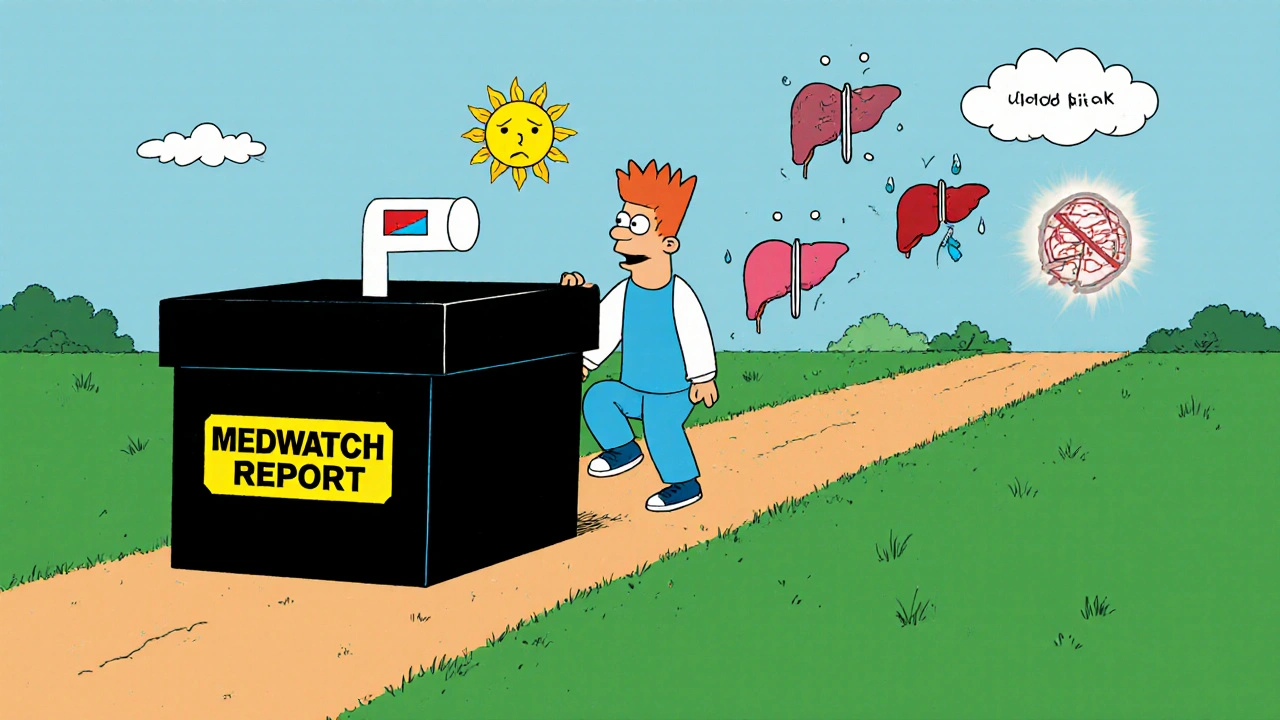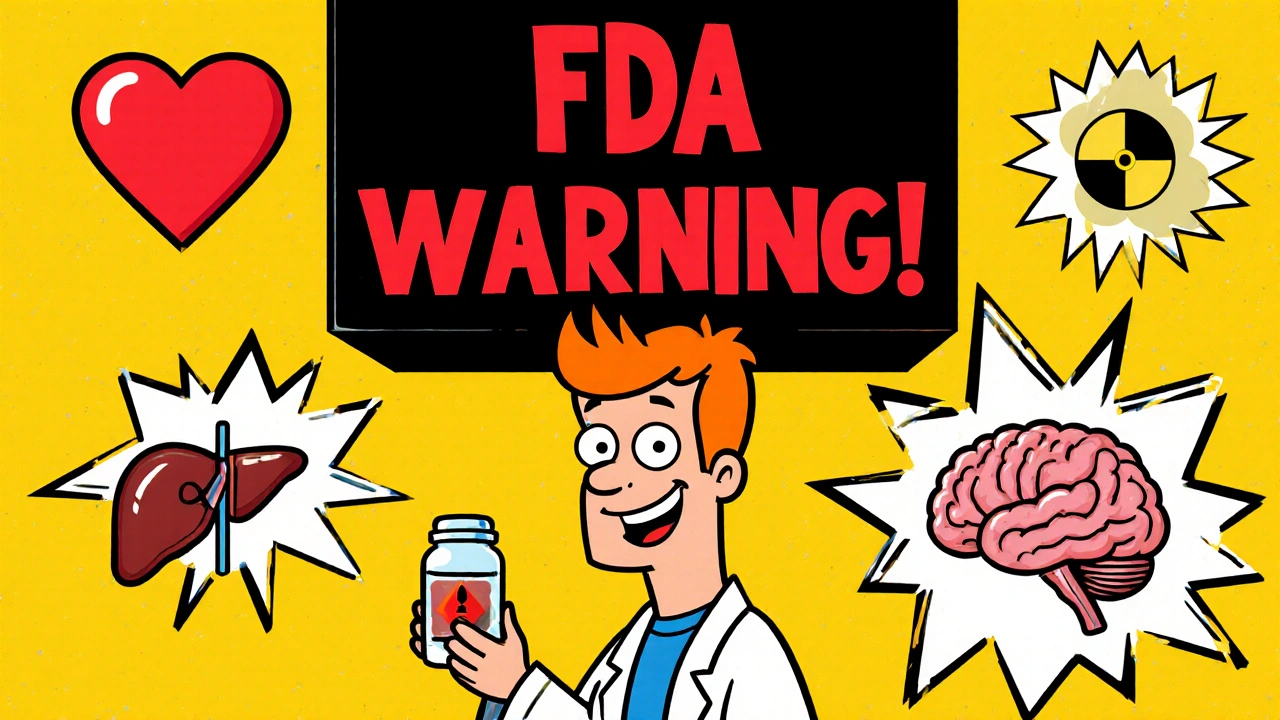Drug Safety Checker
Check if Your Medication Has a Black Box Warning
Enter a drug name (brand or generic) to see if it carries the FDA's strongest safety warning.
When you pick up a prescription, you might not notice the thick black border on the label. But that box? It’s not just design. It’s a red flag from the FDA - the strongest safety warning they can give. Over 400 medications in the U.S. carry this warning. And if you’re taking one, you need to understand what it really means.
What Is a Black Box Warning?
A black box warning is the FDA’s highest-level alert for prescription drugs. It’s printed in a thick black border at the very top of the drug’s official prescribing information. No other warning carries this level of urgency. These aren’t about mild side effects like nausea or dizziness. They’re about risks that can kill - or cause permanent damage.
The FDA doesn’t slap this on lightly. It’s reserved for situations where a drug has been linked to death, serious injury, or life-threatening conditions. Think: heart failure, liver failure, suicidal behavior, severe allergic reactions, or cancer risk. The warning doesn’t say "don’t take this." It says: "This is dangerous. Know exactly why you’re taking it, and watch for these signs."
These warnings are legally required. The FDA mandates the format under 21 CFR 201.56. The text must be clear, direct, and placed where doctors and patients can’t miss it - right after the highlights of prescribing info. And it’s not just on the pill bottle. It’s in the official drug insert, on the FDA website, in medical databases like the Physicians’ Desk Reference, and even on pharmacy websites.
Why Do These Warnings Exist?
Most black box warnings don’t show up during clinical trials. That’s because rare but deadly side effects often only appear after thousands - or millions - of people start using the drug. The FDA doesn’t wait for a disaster. They monitor reports through the FDA Adverse Event Reporting System (FAERS), which gets about 1.3 million reports every year from doctors, patients, and drug companies.
When patterns emerge - like a sudden spike in liver damage among users of a certain diabetes drug - the FDA investigates. If the evidence shows the risk is real, severe, and preventable with proper use, they issue the black box warning.
Take rosiglitazone (Avandia). After studies linked it to heart attacks, the FDA added a black box warning in 2007. Prescriptions dropped by 70%. But even then, over 3 million people kept taking it - because for some, the benefits outweighed the risks. That’s the point: the warning isn’t a ban. It’s a call to pause, think, and talk.
What Kind of Risks Trigger a Black Box Warning?
These warnings don’t just say "dangerous." They specify exactly what could go wrong. Common triggers include:
- Death or organ failure - Like the antibiotic linezolid, which can cause irreversible nerve damage or bone marrow suppression.
- Severe allergic reactions - Carbamazepine, used for seizures, can trigger Stevens-Johnson syndrome - a life-threatening skin condition.
- Increased suicide risk - Antidepressants like fluoxetine carry this warning, especially for teens and young adults.
- Drug interactions - Some medications become deadly when mixed with others, like certain antibiotics with statins.
- Contraindications - Some drugs are outright dangerous for people with specific conditions. For example, estrogen therapies can’t be used by women with a history of breast cancer.
- Special monitoring needed - Drugs like methotrexate require regular blood tests to catch toxicity before it’s too late.
Some warnings even include instructions for safe use. For instance, the HIV drug efavirenz carries a black box warning for birth defects - so women are told to use two forms of birth control while taking it.

How Do These Warnings Change Prescribing?
Doctors don’t ignore black box warnings. They use them as decision-making tools. The STEPS approach - Safety, Tolerability, Effectiveness, Price, Simplicity - helps weigh whether the drug is right for a patient.
For example, if someone has severe rheumatoid arthritis and no other treatments work, a doctor might still prescribe methotrexate - even though it has a black box warning for liver damage and low blood counts. But they’ll order monthly blood tests, avoid alcohol, and monitor closely.
Research shows these warnings work. A 2011 study in Health Affairs found that when rosiglitazone got its warning, prescriptions dropped sharply - but only when media coverage amplified the alert. The similar drug pioglitazone, with the same warning but less publicity, saw no big drop. That tells us: awareness matters.
Some drugs go even further. The FDA requires Risk Evaluation and Mitigation Strategies (REMS) for the riskiest medications. These add layers like mandatory prescriber training, patient registries, or restricted pharmacy dispensing. For example, the acne drug isotretinoin (Accutane) requires patients to enroll in a registry and use two forms of birth control - because of the extreme risk of birth defects.
What Should You Do If Your Drug Has a Black Box Warning?
Don’t panic. Don’t stop cold. But do three things:
- Ask your doctor - Why is this drug right for you? What’s the alternative? What are the exact risks you’re facing?
- Know the signs - If the warning says "watch for jaundice," know what yellow skin or dark urine looks like. If it says "risk of suicidal thoughts," know what changes in mood to report.
- Report side effects - Use the FDA’s MedWatch program. Every year, about 200,000 patients report reactions this way. Your report could help save someone else’s life.
Pharmacists are also a key resource. If you’re on a black box drug, ask them to review your full medication list. Many dangerous interactions happen because multiple doctors are prescribing without knowing what else you’re taking.

Are Black Box Warnings Perfect?
No. They’re not foolproof. Studies show many patients never discuss the warning with their doctor. Some assume it means "never take this," while others ignore it entirely. That’s why clarity matters - and why the FDA updated its labeling guidelines in 2021 to make warnings more readable and consistent.
Another problem? Warnings are broad. They apply to everyone taking the drug, even if only a small group is at risk. That’s changing. The FDA’s 2023-2027 plan aims to use pharmacogenomics - testing your genes - to make warnings more precise. Imagine a warning that says: "This drug increases your risk of liver damage only if you have the CYP2C9*3 gene variant." That’s the future.
For now, the system relies on human judgment. The FDA doesn’t want to scare people away from life-saving drugs. It wants to make sure you know the cost - and that you’re making the choice with your eyes wide open.
Where to Find Current Black Box Warnings
You don’t need to guess. The FDA keeps a free, searchable database called Drugs@FDA. You can look up any approved drug and see its full labeling - including the black box warning - in plain language. You can also check the Drug Effectiveness Review Project or Consumer Reports Best Buy Drugs for independent analysis of risks versus benefits.
And if you’re ever unsure, call your pharmacist. They’re trained to read these warnings and explain them in real terms - not legal jargon.
Black box warnings aren’t about fear. They’re about respect - for the power of medicine, and for your right to know what you’re putting in your body.
Does a black box warning mean I can’t take the drug?
No. A black box warning doesn’t mean the drug is banned or unsafe for everyone. It means the risks are serious enough that your doctor must carefully weigh them against the benefits. Many people take black box drugs safely - like chemotherapy for cancer, or antidepressants for severe depression - because the alternative is worse. The warning ensures you’re informed before you start.
Can a black box warning be removed?
Yes. If new evidence shows the risk is lower than originally thought - or if safer use practices reduce harm - the FDA can remove or modify the warning. For example, warnings for certain birth control pills were updated after better data showed lower blood clot risks in younger women. Removal requires new clinical studies or long-term safety data.
Are over-the-counter drugs ever given black box warnings?
Rarely. Black box warnings are almost always for prescription drugs. The FDA’s authority to mandate them applies primarily to prescription medications. Some OTC drugs have strong warnings - like aspirin and Reye’s syndrome in children - but they don’t use the black box format. That’s reserved for the most serious prescription risks.
Do black box warnings affect drug prices?
Often, yes. After a black box warning is added, sales typically drop 25-40% in the first year. That’s because doctors prescribe alternatives, and some patients refuse the drug. But if the drug treats a serious condition with few options - like certain cancers or autoimmune diseases - sales often stabilize. The warning doesn’t kill demand; it reshapes it.
How long does it take for the FDA to issue a black box warning?
There’s no set timeline. It can take months or years. The FDA waits for enough reports to show a clear, repeatable pattern - not just one or two cases. They analyze over a million adverse event reports annually. Once the evidence is strong, the agency consults experts, reviews clinical data, and may hold public meetings before making a final decision. The process is slow by design - to avoid panic over unproven risks.
Can I report a side effect even if I’m not sure it’s related?
Absolutely. The FDA encourages anyone - patients, caregivers, or doctors - to report any unusual reaction, even if you’re not certain. If others report similar symptoms, patterns emerge. You don’t need to prove causation. Just describe what happened, when, and what you were taking. Reports go into the FAERS database and help shape future warnings.
Are black box warnings the same worldwide?
No. The U.S. FDA’s black box is unique in its format and legal weight. Other countries have similar systems - like the UK’s "red flag" warnings or the EU’s "contraindications" - but they’re not standardized. A drug with a black box warning in the U.S. might have a milder alert elsewhere. Always check your country’s drug regulator for local guidance.
What’s Next for Black Box Warnings?
The future is personal. Instead of warning everyone the same way, the FDA is moving toward precision alerts. Imagine getting a warning only if your genetic test shows you’re at higher risk. Or a digital label that updates in real time based on your age, other medications, or kidney function.
Right now, the system works because it’s loud. But soon, it might be smarter - not just louder. Until then, your best tool is knowledge. Read the warning. Ask questions. Don’t assume. And never be afraid to say, "I need to understand this better."


Arpita Shukla
Black box warnings are just the tip of the iceberg. Most patients don’t even read the insert, and doctors rush through counseling. I’ve seen people on methotrexate skip bloodwork for months because they ‘felt fine.’ The system’s broken when the most critical info is buried in 40-page PDFs. The FDA needs mandatory pop-ups at pharmacies - like a flashing sign: ‘THIS DRUG CAN KILL YOU IF YOU IGNORE THIS.’